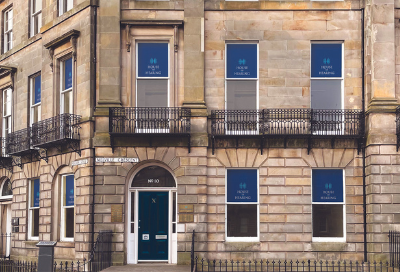
Hearing Loops in Scotland and Beyond
Hearing Loops in Scotland and Beyond!
You may have noticed the hearing loop symbol outside shops and tourist attractions. But what do these symbols mean, and what do hearing loops do?
Hearing loop systems (also known as induction loops) are installed in public locations to help people with hearing aids hear more clearly. The system can broadcast sounds such as speech and announcements directly to a person’s hearing aid. For Scotland’s 168,000 hearing aid users, hearing loops are a cost-effective way to make life a lot easier and help people to negotiate noisy spaces and use public facilities smoothly. They can also be life-enriching, allowing people with hearing loss to hear every word of a lecture, sermon or theatre performance directly in their hearing aids.
How do they work?
Most hearing aids have a small copper coil inside them, known as a telecoil or t-coil, which acts as a receiver. When the telecoil is switched on, it receives sounds from an external microphone rather than the device’s internal microphone.
If you’re in a location with the hearing loop symbol displayed, simply switch your hearing aid to the “T” or telecoil setting. Your device will picks up sounds from the hearing loop system microphone, installed somewhere in the area. Excess background noise is cancelled out, and you will be able to clearly hear sounds such as speech broadcast through the loop system microphone.
Hearing loops systems mean that users don’t need to use extra handheld devices or spend time fiddling with their hearing aids in public.
There are several types of hearing loops:
A room loop
A room loop is used in places like lecture halls, places of worship, theatres, community centres and homes. The system helps to overcome problems such as distance from the speaker, bad acoustics and background noise.
An infra-red loop
An infra-red loop is similar to a room loop but uses individual personal receivers which are lent to the user by the venue. These systems are commonly used in theatres and cinemas.
A counter loop
A counter loop is used at customer service desks, like shop tills, bank counters, ticket offices and receptions.
A portable loop
A portable loop contains an entire loop system within a single easy-to-carry device. They do not require any installation, and are useful in temporary situations like meetings and interviews. They have a more limited range than installed loops.
Where can you find them in Scotland?
Hearing loops can be found all over the place. In fact, all retail outlets such as shops and restaurants are required to provide this service by law, under the Equality Act of 2010. You’ll find them in hospitals, libraries, post offices, banks, GP surgeries, train stations, airports, and sport venues. Many taxis and trains also have hearing loop systems installed.
Public venues and tourist attractions such as theatres, museums, music venues, cinemas and places of worship also often have loop systems. Most venues will have an Accessibility page on their website, which can let you know if they have a system.
If you’re looking for a hearing loop day out, why not try some of these attractions?
The National Galleries of Scotland offer portable hearing loops for its guided tours, lectures and talks, for a cultural day out. Hearing loops are also fitted in their lecture halls and education suites.
Scottish Parliament has hearing loops installed throughout its buildings, including the debating chamber, public galleries, education centre and crèche. They also provide portable loop systems for all their guided tours.
Perth Concert Hall and Theatre have induction loop and infra-red systems for hearing aid users. Staff can advise on the best seats in the house if you’re using a hearing aid – ask at the box office.
The Scotch Whiskey Experience in Edinburgh offers hearing loops on interactive whiskey barrel ride through a virtual distillery – sure to be a memorable day out!
Royal Yacht Britannia, voted Scotland’s Best Visitor Attraction, has a hearing loop system throughout its entire route. Explore this unique royal residence at your leisure!
We’re happy to answer your questions on hearing loops, hearing aids or anything else to do with hearing health. Pop in to one of our centres or give us a call on 0131 220 1220.
House of Hearing UK
0131-220-1220
Edinburgs | Galashiels | Perth | St Andrews
Our Clinics
All House of Hearing clinics are in town centre locations and accessible to public transport and parking. Home visits also available if mobility is an issue.


.png)
.png)
.png)

.png)
